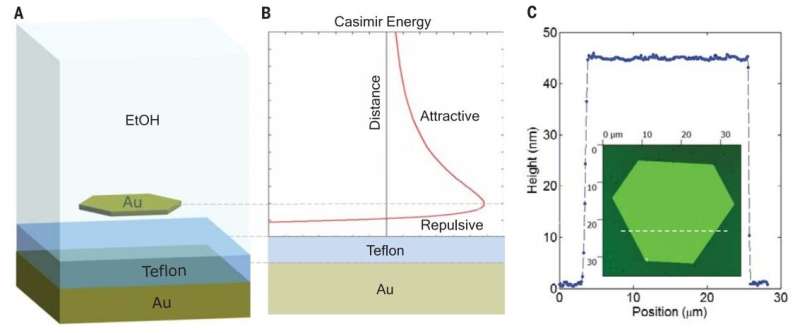June 10, 2019 report
Researchers find a way to make Casimir effect attract or repulse depending on gap size

A team of researchers from the University of California at Berkeley and Lawrence Berkeley National Laboratory has found a way to make the Casimir effect attract or repulse depending on the size of the gap between two objects. In their paper published in the journal Science, the group describes their technique and possible applications.
The Casimir effect, first proposed by Hendrik Casimir back in 1948, is the phenomenon in which two tiny surfaces in close proximity experience a force that pulls them closer together. Quantum fluctuations inside and outside of the gap push against the plates, but because those pushing from the outside are stronger, they create an attractive force between the two plates. The Casimir effect is more than a curiosity, because it can create problems in nanotechnology applications.
Just two years after Casimir first proposed the effect, others in the field began making predictions about ways to counter it—making it repulsive rather than attractive, for example, in the case of fluids and plates made of lower refractive metals. Then, in 2010, a team at MIT suggested that it should be possible to counter both attractive and repulsive effects to create a state of equilibrium between the two plates. In this new effort, the researchers report that they have done just that.
The work involved coating a gold plate with Teflon and suspending a tiny gold flake in ethanol just above it. They explain that because the Teflon has a lower refractive index than ethanol, it makes the two materials repulsive. But the interaction between the gold flake and the gold plate was attractive, creating a counter force. By placing all the components at just the right distance apart, they were able to achieve equilibrium. The system also allows for switching between the equilibrium state and either an attractive or repulsive state by moving one or more of the materials.
The researchers suggest their technique could be used in nanomechanical devices or even in computers, where it could be used to reduce stiction, which is one of the primary causes ofcomputer crashes.
More information: Rongkuo Zhao et al. Stable Casimir equilibria and quantum trapping, Science (2019). DOI: 10.1126/science.aax0916
Journal information: Science
© 2019 Science X Network


















